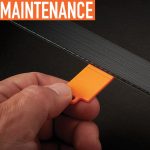The recent trend in the industry is to specify and build newer commercial vehicles with air disc brakes. Commercial air disc brakes are quite different from the more well-known s-cam (or drum brakes) that have been quite common in North America for many years. Air disc brakes, while offering advantages to the fleet operator, also present difficulties and challenges when it comes to inspection and maintenance of these brake systems. Figure 1 and Figure 2 are illustrations showing a typical s-cam (drum), and a typical air disc application for modern commercial vehicles.
MAINTENANCE WOES
In Figure 1, you can see a typical s-cam (drum) application that includes a brake chamber with an exposed pushrod, an automatic brake adjuster (ABA), a s-cam tube and bushings, cam rollers, linings, and a drum. In this application, all parts are basically “exposed,” which allows the fleet operator to visually check and inspect s-cam equipped vehicles using standard industry inspection criteria as defined by CDL requirements. Major component malfunctions can be visually checked and inspected by placing the vehicle on a lift and actuating the brakes, or through the use of electronic brake monitoring. The Commercial Vehicle Safety Alliance (CVSA) has standard procedures for checking brake function and stroke for these applications.

In Figure 2, you can see a typical air disc application that includes a brake chamber with a fully enclosed pushrod, a brake caliper with an internal adjuster mechanism, a rotor, and brake pads. This type of braking system poses challenges to the fleet in terms of visual brake inspections. There is no exposed pushrod in order to check chamber stroke, and the internal adjuster mechanism (designed to keep pad clearance constant like an ABA on s-cam systems) is fully enclosed, sealed, and not possible to visually inspect. In addition, the pads and outboard rotor face are nearly hidden from view making it difficult to check pads or rotor conditions visually, without wheel removal for subsequent detailed inspections.

The industry has long known that a visual inspection of air disc brakes for proper operation is impractical, and this has been acknowledged by CVSA as a serious concern. The most common visual inspection method employed is simply to “check the rotor for rust,” which would indicate the brake is inoperative (can require wheel removal).
Thus, with air disc brakes the fleet operator does not truly know with a visual inspection any of the following:
- Whether the brake actuator (or brake chamber) is operative
- Whether the caliper internal adjuster is operative and maintaining pad clearance under all conditions
- Whether the wheel end is providing full braking, partial braking, or no braking
- Whether the brake actuator (or brake chamber) stroke is within acceptable operating limits
- Whether the brake is lightly dragging (warning of other serious problems)
E-BRAKE MONITORING
The vehicles in a commercial fleet are valuable and costly assets, not to mention the associated liability if a fleet transports personnel or hazardous and high dollar cargo as a daily part of its operations. The government and scientific data is clear. There is a direct proven relationship between commercial vehicle air brake operation and the inherent risk or severity of being involved in an accident.
Now, add the complexity of being able to properly and fully visually inspect and maintain a vehicle’s air brake system and a strong case can be made for upfront investment in electronic brake monitoring. The cost of one vehicle total loss, or associated liability costs of a vehicle collision, can quickly justify the need for the technology. In addition, electronic brake monitoring can significantly reduce maintenance costs and identify brake problems before they become more extensive and costly.
Electronic brake monitoring can accurately find and identify the following typical air brake system problems:
- Air brake system electrical control and air valve failures (including ice in the air system)
- Broken air lines and hoses
- Defective brake actuators (brake chambers)
- Defective automatic brake adjusters (ABAs)
- Defective caliper operation (internal adjuster mechanism)
- Defective service or parking brake operation
- Low caliper pad clearance resulting in light drag and excessive pad wear
- Dragging brakes, which can result in a thermal event
- Out of adjustment brakes (over-stroke), which leads to reduced braking performance
- Missing brake pads or rotor sections
- Broken s-cam tubes, worn pads and brake drums, and other mechanical issues
- Non-functioning brakes (wheel ends where no braking is being performed)
ADDITIONAL CAPABILITIES
Electronic brake monitoring (when integrated with the vehicle control systems), can offer many other additional capabilities. This is accomplished via the vehicle I/O system or via the vehicle J-1939 network, including a Dragging Brake Intervention System. If MGM’s electronic brake monitoring system detects a continuous and dangerous dragging brake condition on the vehicle, the following safety sequence is automatically initiated to protect the vehicle and occupants:
- After 30 seconds of continuous driving, the warning light will illuminate (or the intelligent display will message the driver) indicating a brake drag is present.
- After 60 seconds of continuous driving, the warning light will begin to flash (or the intelligent display will flash the message to the driver) indicating a brake drag is present.
- After 90 seconds of continuous driving, an audible alarm will sound and the vehicle four-way flashers will automatically engage.
- After 120 seconds of continuous driving, the engine will de-rate to a top speed of 15 mph, allowing the driver to safely move the vehicle out of traffic and to a safe parking position.
- Once the vehicle is parked, the interlocks will automatically engage and the vehicle will go into lockdown awaiting a maintenance technician service call.
Other possible advantages or uses of electronic brake monitoring include:
- Automating pre-trip inspection procedure
- Capturing brake application pressure data during panic stops
- Using the electronic brake monitoring logging feature during accident investigations
CLOSING COMMENTS
Out of adjustment brakes continue to be found in significant numbers during inspections despite the prevalence of automatic brake adjusters and fleet preventive maintenance efforts. An analysis of the Large Truck Crash Causation Study database by UMTRI (shown in Part 1 of this article) indicates that ⅓ of the trucks involved in fatal accidents had at least one brake out of adjustment, and that brake adjustment was the only mechanical defect that was found to have a statistically significant relationship to accident causation.
Advanced crash avoidance technologies, such as ESC, RSC, adaptive cruise control, and automatic braking will not perform properly if the foundation brakes are not properly operating and adjusted. Modern air disc brakes, unlike s-cam (drum) brakes are fully enclosed and their proper function cannot be determined with a simple visual inspection. Electronic brake monitoring is commercially available for both s-cam (drum) and air-disc foundation brakes. Electronic brake monitoring is not only capable of detecting brakes out of adjustment, but also inoperative brakes, dragging brakes, and broken springs in parking and emergency brakes.
Significant progress has been made in automotive safety, but much room for improvement remains. Technology, when properly adopted, can save lives. The data is clear, and the technology exists to address this industry issue.
ABOUT THE AUTHOR
Matt Cleveland is the sales engineer, Heavy-Duty Market, for Gates Corporation. Drew Conkling is the product marketing manager, Belts and Accessory Component Kits, for Gates Corporation. Find out more about Gates Corporation, visit www.gates.com.
_______________________________________________________________________
MODERN WORKTRUCK SOLUTIONS: April 2017 ISSUE
Did you enjoy this article?
Subscribe to the FREE Digital Edition of Modern WorkTruck Solutions magazine.
![]()




